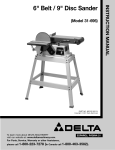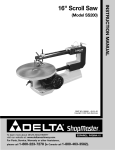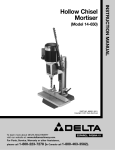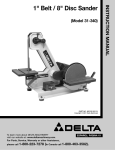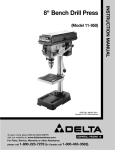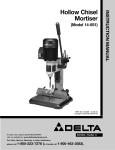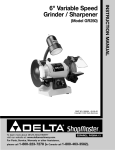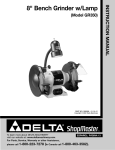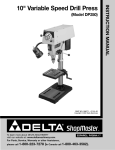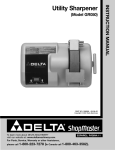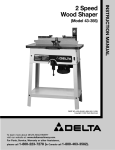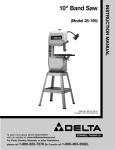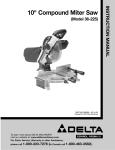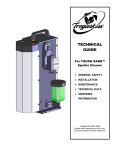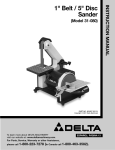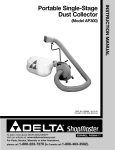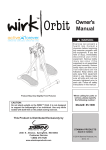Download Delta MM300 Instruction manual
Transcript
(Model MM300) PART NO. 906119 - 06-15-02 Copyright © 2002 Delta Machinery To learn more about DELTA MACHINERY visit our website at: www.deltamachinery.com. For Parts, Service, Warranty or other Assistance, please call ESPAÑOL: PÁGINA 19 1-800-223-7278 (In Canada call 1-800-463-3582). INSTRUCTION MANUAL Hollow Chisel Mortiser GENERAL SAFETY RULES Woodworking can be dangerous if safe and proper operating procedures are not followed. As with all machinery, there are certain hazards involved with the operation of the product. Using the machine with respect and caution will considerably lessen the possibility of personal injury. However, if normal safety precautions are overlooked or ignored, personal injury to the operator may result. Safety equipment such as guards, push sticks, hold-downs, featherboards, goggles, dust masks and hearing protection can reduce your potential for injury. But even the best guard won’t make up for poor judgment, carelessness or inattention. Always use common sense and exercise caution in the workshop. If a procedure feels dangerous, don’t try it. Figure out an alternative procedure that feels safer. REMEMBER: Your personal safety is your responsibility. This machine was designed for certain applications only. Delta Machinery strongly recommends that this machine not be modified and/or used for any application other than that for which it was designed. If you have any questions relative to a particular application, DO NOT use the machine until you have first contacted Delta to determine if it can or should be performed on the product. Technical Service Manager Delta Machinery 4825 Highway 45 North Jackson, TN 38305 (IN CANADA: 505 SOUTHGATE DRIVE, GUELPH, ONTARIO N1H 6M7) WARNING: FAILURE TO FOLLOW THESE RULES MAY RESULT IN SERIOUS PERSONAL INJURY 1. FOR YOUR OWN SAFETY, READ INSTRUCTION MANUAL BEFORE OPERATING THE TOOL. Learn the tool’s application and limitations as well as the specific hazards peculiar to it. 2. KEEP GUARDS IN PLACE and in working order. 3. ALWAYS WEAR EYE PROTECTION. Wear safety glasses. Everyday eyeglasses only have impact resistant lenses; they are not safety glasses. Also use face or dust mask if cutting operation is dusty. These safety glasses must conform to ANSI Z87.1 requirements. NOTE: Approved glasses have Z87 printed or stamped on them. 4. REMOVE ADJUSTING KEYS AND WRENCHES. Form habit of checking to see that keys and adjusting wrenches are removed from tool before turning it “on”. 5. KEEP WORK AREA CLEAN. Cluttered areas and benches invite accidents. 6. DON’T USE IN DANGEROUS ENVIRONMENT. Don’t use power tools in damp or wet locations, or expose them to rain. Keep work area well-lighted. 7. KEEP CHILDREN AND VISITORS AWAY. All children and visitors should be kept a safe distance from work area. 8. MAKE WORKSHOP CHILDPROOF – with padlocks, master switches, or by removing starter keys. 9. DON’T FORCE TOOL. It will do the job better and be safer at the rate for which it was designed. 10. USE RIGHT TOOL. Don’t force tool or attachment to do a job for which it was not designed. 11. WEAR PROPER APPAREL. No loose clothing, gloves, neckties, rings, bracelets, or other jewelry to get caught in moving parts. Nonslip footwear is recommended. Wear protective hair covering to contain long hair. 12. SECURE WORK. Use clamps or a vise to hold work when practical. It’s safer than using your hand and frees both hands to operate tool. 13. DON’T OVERREACH. Keep proper footing and balance at all times. 14. MAINTAIN TOOLS IN TOP CONDITION. Keep tools sharp and clean for best and safest performance. Follow instructions for lubricating and changing accessories. 15. DISCONNECT TOOLS before servicing and when changing accessories such as blades, bits, cutters, etc. 16. USE RECOMMENDED ACCESSORIES. The use of accessories and attachments not recommended by Delta may cause hazards or risk of injury to persons. 17. REDUCE THE RISK OF UNINTENTIONAL STARTING. Make sure switch is in “OFF” position before plugging in power cord. In the event of a power failure, move switch to the “OFF” position. 18. NEVER STAND ON TOOL. Serious injury could occur if the tool is tipped or if the cutting tool is accidentally contacted. 19. CHECK DAMAGED PARTS. Before further use of the tool, a guard or other part that is damaged should be carefully checked to ensure that it will operate properly and perform its intended function – check for alignment of moving parts, binding of moving parts, breakage of parts, mounting, and any other conditions that may affect its operation. A guard or other part that is damaged should be properly repaired or replaced. 20. DIRECTION OF FEED. Feed work into a blade or cutter against the direction of rotation of the blade or cutter only. 21. NEVER LEAVE TOOL RUNNING UNATTENDED. TURN POWER OFF. Don’t leave tool until it comes to a complete stop. 22. STAY ALERT, WATCH WHAT YOU ARE DOING, AND USE COMMON SENSE WHEN OPERATING A POWER TOOL. DO NOT USE TOOL WHILE TIRED OR UNDER THE INFLUENCE OF DRUGS, ALCOHOL, OR MEDICATION. A moment of inattention while operating power tools may result in serious personal injury. 23. MAKE SURE TOOL IS DISCONNECTED FROM P O W E R S U P P LY w h i l e m o t o r i s b e i n g m o u n t e d , connected or reconnected. 24. THE DUST GENERATED by certain woods and wood products can be injurious to your health. Always operate machinery in well ventilated areas and provide for proper dust removal. Use wood dust collection systems whenever possible. 25. WARNING: SOME DUST CREATED BY POWER SANDING, SAWING, GRINDING, DRILLING, AND OTHER CONSTRUCTION ACTIVITIES contains chemicals known to cause cancer, birth defects or other reproductive harm. Some examples of these chemicals are: · lead from lead-based paints, · crystalline silica from bricks and cement and other masonry products, and · arsenic and chromium from chemically-treated lumber. Your risk from these exposures varies, depending on how often you do this type of work. To reduce your exposure to these chemicals: work in a well ventilated area, and work with approved safety equipment, such as those dust masks that are specially designed to filter out microscopic particles. SAVE THESE INSTRUCTIONS. Refer to them often and use them to instruct others. 2 ADDITIONAL SAFETY RULES FOR HOLLOW CHISEL MORTISERS WARNING: FAILURE TO FOLLOW THESE RULES MAY RESULT IN SERIOUS PERSONAL INJURY. 1. DO NOT OPERATE THIS MACHINE until it is assembled and installed according to the instructions. 15. ALWAYS turn off the power before removing scrap pieces from the table. 2. OBTAIN ADVICE FROM YOUR SUPERVISOR, instructor, or another qualified person if you are not familiar with the operation of this machine. 16. SHUT-OFF the power, remove the drill bit and chisel, and clean the table before leaving the machine. 17. FOR YOUR OWN SAFETY – Don’t wear gloves when operating the machine. 3. FOLLOW ALL WIRING CODES and recommended electrical connections. 5. NEVER turn the mortiser “ON” before clearing the table of all objects (tools, scrap pieces, etc.). 18. SHOULD any part of your tool be missing, damaged, or fail in any way, or any electrical component fail to perform properly, shut off switch and remove plug from power supply outlet. Replace missing, damaged, or failed parts before resuming operation. 6. ALWAYS keep hands, fingers and hair away from the rotating bit. 19. THE USE of attachments and accessories not recommended by Delta may result in the risk of injuries. 7. DO NOT attempt to mortise material that does not have a flat surface, unless a suitable support is used. 20. TURN THE MACHINE “OFF” AND DISCONNECT THE MACHINE from the power source before installing or removing accessories, before adjusting or changing set-ups, or when making repairs. 4. MAKE CERTAIN the machine is fastened to a supporting surface to prevent it from tipping over during operation. 8. ALWAYS position holddown directly over workpiece to prevent workpiece from lifting during operation. 21. TURN THE MACHINE “OFF”, disconnect the machine from the power source, and clean the table/work area before leaving the machine. LOCK THE SWITCH IN THE “OFF” POSITION to prevent unauthorized use. 9. ALWAYS support workpiece securely against fence to prevent rotation. 10. BE SURE drill bit is sharp, not damaged, and properly secured in the chuck before operation. 11. MAKE SURE chuck key is removed before starting machine. 22. ADDITIONAL INFORMATION regarding the safe and proper operation of this tool is available from the Power Tool Institute, 1300 Summer Avenue, Cleveland, OH 44115-2851. Information is also available from the National Safety Council, 1121 Spring Lake Drive, Itasca, IL 60143-3201. Please refer to the American National Standards Institute ANSI 01.1 Safety Requirements for Woodworking Machines and the U.S. Department of Labor OSHA 1910.213 Regulations. 12. NEVER turn on the power with the drill bit or chisel contacting the workpiece. 13. NEVER perform layout, assembly, or set-up work on the table while the mortiser is operating. 14. ADJUST the depth stop to avoid drilling into the table. SAVE THESE INSTRUCTIONS. Refer to them often and use them to instruct others. 3 POWER CONNECTIONS A separate electrical circuit should be used for your machines. This circuit should not be less than #12 wire and should be protected with a 20 Amp time lag fuse. If an extension cord is used, use only 3-wire extension cords which have 3prong grounding type plugs and matching receptacle which will accept the machine’s plug. Before connecting the motor to the power line, make sure the switch is in the “OFF” position and be sure that the electric current is of the same characteristics as indicated on the machine. All line connections should make good contact. Running on low voltage will damage the motor. WARNING: DO NOT EXPOSE THE MACHINE TO RAIN OR OPERATE THE MACHINE IN DAMP LOCATIONS. MOTOR SPECIFICATIONS Your machine is wired for 120 volt, 60 HZ alternating current. Before connecting the machine to the power source, make sure the switch is in the “OFF” position. GROUNDING INSTRUCTIONS WARNING: THIS MACHINE MUST BE GROUNDED WHILE IN USE TO PROTECT THE OPERATOR FROM ELECTRIC SHOCK. 1. All grounded, cord-connected machines: 2. Grounded, cord-connected machines intended for use on a supply circuit having a nominal rating less than 150 In the event of a malfunction or breakdown, grounding volts: provides a path of least resistance for electric current to reduce the risk of electric shock. This machine is If the machine is intended for use on a circuit that has an equipped with an electric cord having an equipmentoutlet that looks like the one illustrated in Fig. A, the grounding conductor and a grounding plug. The plug must machine will have a grounding plug that looks like the plug be plugged into a matching outlet that is properly installed illustrated in Fig. A. A temporary adapter, which looks like and grounded in accordance with all local codes and the adapter illustrated in Fig. B, may be used to connect ordinances. this plug to a matching 2-conductor receptacle as shown in Fig. B if a properly grounded outlet is not available. The Do not modify the plug provided - if it will not fit the outlet, temporary adapter should be used only until a properly have the proper outlet installed by a qualified electrician. grounded outlet can be installed by a qualified electrician. Improper connection of the equipment-grounding The green-colored rigid ear, lug, and the like, extending conductor can result in risk of electric shock. The from the adapter must be connected to a permanent conductor with insulation having an outer surface that is ground such as a properly grounded outlet box. Whenever green with or without yellow stripes is the equipmentthe adapter is used, it must be held in place with a metal grounding conductor. If repair or replacement of the screw. electric cord or plug is necessary, do not connect the equipment-grounding conductor to a live terminal. NOTE: In Canada, the use of a temporary adapter is not permitted by the Canadian Electric Code. Check with a qualified electrician or service personnel if t h e g ro u n d i n g i n s t r u c t i o n s a re n o t c o m p l e t e l y understood, or if in doubt as to whether the machine is WARNING: IN ALL CASES, MAKE CERTAIN THE properly grounded. RECEPTACLE IN QUESTION IS PROPERLY G R O U N D E D . I F Y O U A R E N O T S U R E H AV E A Use only 3-wire extension cords that have 3-prong QUALIFIED ELECTRICIAN CHECK THE RECEPTACLE. grounding type plugs and matching 3-conductor receptacles that accept the machine’s plug, as shown in Fig. A. Repair or replace damaged or worn cord immediately. GROUNDED OUTLET BOX GROUNDED OUTLET BOX GROUNDING MEANS CURRENT CARRYING PRONGS ADAPTER GROUNDING BLADE IS LONGEST OF THE 3 BLADES Fig. A 4 Fig. B EXTENSION CORDS Use proper extension cords. Make sure your extension cord is in good condition and is a 3-wire extension cord which has a 3-prong grounding type plug and matching receptacle which will accept the machine’s plug. When using an extension cord, be sure to use one heavy enough to carry the current of the machine. An undersized cord will cause a drop in line voltage, resulting in loss of power and overheating. Fig. D, shows the correct gauge to use depending on the cord length. If in doubt, use the next heavier gauge. The smaller the gauge number, the heavier the cord. MINIMUM GAUGE EXTENSION CORD RECOMMENDED SIZES FOR USE WITH STATIONARY ELECTRIC MACHINES Ampere Rating Volts Total Length of Cord in Feet Gauge of Extension Cord 0-6 0-6 0-6 0-6 120 120 120 120 up to 25 25-50 50-100 100-150 18 AWG 16 AWG 16 AWG 14 AWG 6-10 6-10 6-10 6-10 120 120 120 120 up to 25 25-50 50-100 100-150 18 AWG 16 AWG 14 AWG 12 AWG 10-12 10-12 10-12 10-12 120 120 120 120 up to 25 25-50 50-100 100-150 16 AWG 16 AWG 14 AWG 12 AWG 12-16 12-16 12-16 120 120 120 up to 25 25-50 14 AWG 12 AWG GREATER THAN 50 FEET NOT RECOMMENDED Fig. D OPERATING INSTRUCTIONS FOREWORD Delta ShopMaster Model MM300 is easier to operate than a conventional drill press equipped with a mortising attachment. The model MM300 is made of cast-iron and steel for rigidity and stability. The motriser comes with a standard 3-jaw type key chuck for positive gripping of mortising bits. UNPACKING AND CLEANING Carefully unpack the machine and all loose items from the shipping container(s). Remove the protective coating from all unpainted surfaces. This coating may be removed with a soft cloth moistened with kerosene (do not use acetone, gasoline or lacquer thinner for this purpose). After cleaning, cover the unpainted surfaces with a good quality household floor paste wax. NOTICE: THE MANUAL COVER PHOTO ILLUSTRATES THE CURRENT PRODUCTION MODEL. ALL OTHER ILLUSTRATIONS ARE REPRESENTATIVE ONLY AND MAY NOT DEPICT THE ACTUAL COLOR, LABELING OR ACCESSORIES AND MAY BE INTENDED TO ILLUSTRATE TECHNIQUE ONLY. 5 HOLLOW CHISEL MORTISER PARTS O L M P A N Q D C B E K F G I R S J H T U Fig. 2 A - Mortising Machine M - M6x1x35mm Flat Head Screws (2) (for assembling table to base) B - Chuck Key N - M6x1x25mm Pan Head Screws (2) (for assembling tool and chisel holder) C - Wrench D - Tool and Chisel Holder O - Spring (for raising and lowering handle) E - Hydraulic Cylinder P - T-Nuts (2) (for assembling table to base) F - Fence G - Holddown Q - M6 Flat Washers (2) (for assembling tool and chisel holder) H - Bar (for mounting holddown) R - 1/2" Mortising Chisel and Bit I - Table S - 3/8" Mortising Chisel and Bit J - Raising and Lowering Handle T - 5/16" Mortising Chisel and Bit K - Fence Locking Handle Assembly U - 1/4" Mortising Chisel and Bit L - Special Screw (for raising and lowering handle) 6 ASSEMBLY WARNING: FOR YOUR OWN SAFETY, DO NOT CONNECT THE MACHINE TO THE POWER SOURCE UNTIL THE MACHINE IS COMPLETELY ASSEMBLED AND YOU READ AND UNDERSTAND THE ENTIRE INSTRUCTION MANUAL. B RAISING AND LOWERING HANDLE A 1. Assemble hub of handle assembly (A) Fig. 3, to end of pinion shaft (B) and fasten handle to pinion shaft using special screw (C) and spring (D). D C Fig. 3 B 2. Raise mortising machine head (E) Fig. 4, to the up position by turning handle (A) clockwise. NOTE: Handle (A) is spring-loaded and can be repositioned by pulling out handle and repositioning it on pinion shaft (B). A E Fig. 4 HYDRAULIC CYLINDER A 1. Make sure head (A) Fig. 5, is held in the up position and assemble the hydraulic cylinder (B) to the two fittings (C), one located on the column and the other on the back of the head. B C Fig. 5 2. Fig. 6, illustrates the hydraulic cylinder (B) assembled to the machine. The hydraulic cylinder (B) keeps the head in the up position. B Fig. 6 7 TABLE 1. Assemble the table (A) Fig. 7, to the base using the two M6x1x35mm flat head screws (B) and T-nuts (C). Insert the two screws (B) into the two holes (D) in table (A). Place the two T-nuts (C) into the slots (E) provided in the bottom of the base and tighten the two screws (B) into the two T-nuts (C) securely. E A D C B E 2. The table (A) Fig. 7, can be moved in or out by loosening the two screws (B), and re-positioning the table, and then tightening screws (B). Fig. 7 FENCE AND HOLDDOWN C 1. Locate handle assembly and remove screw (A) Fig. 8, and spring (B) from handle (C). Sperate handle (C) from stud (D). D B A Fig. 8 2. Thread stud (D) Fig. 9, into hole on side of column, as shown. Do not thread stud (D) all the way into hole at this time. D 3. Reassemble handle (C) Fig. 9, on stud (D) and replace screw (A) and spring (B). C B A Fig. 9 4. Fig. 10 illustrates the handle assembly (C) attached to the column. C Fig. 10 8 5. Insert bar of fence assembly (E) Fig. 11, through hole in column as shown. Tighten handle (C) against flat on fence bar to hold fence in position. NOTE: Handle (C) is spring-loaded and can be repositioned on the stud located underneath the handle by pulling out the handle and repositioning it on the stud. E C Fig. 11 6. Insert bar (F) Fig. 12, into hole on top of fence as shown, and tighten set screw (G) against flat on bar (F). F G Fig. 12 7. Assemble the holddown (H) Fig. 13, onto bar (F) as shown, and tighten set screw (J) against flat on bar. H J F TOOL AND CHISEL HOLDER 1. Assemble tool and chisel holder (A) Fig. 14, to side of column using the two M6x1x25mm screws (B) and M6 flat washers as shown. Fig. 13 2. Fig. 15, illustrates the chuck key (C), wrench (D) and chisels and bits (E) in holes of tool and chisel holder (A) when not in use. E D B C A A Fig. 14 Fig. 15 9 FASTENING MACHINE TO SUPPORTING SURFACE If during operation there is any tendency for the mortiser to tip over, slide or walk on the supporting surface, the base must be secured to the supporting surface with fasteners (not supplied), through the two holes (A) Fig. 16, located in the mortiser base. A A Fig. 16 ASSEMBLING CHISEL AND BIT 1. DISCONNECT MACHINE FROM POWER SOURCE. A 2. Insert bit (A) Fig. 20, into chisel (B). NOTE: The opening (C) on the side of the chisel should always be to the right or left, never to the front or rear. The opening allows chips to escape during operation. B C Fig. 20 D B 3. Loosen screw (D) Fig. 21, and push chisel (B) up through hole in head as far as possible. Then lower chisel (B) 1/16" to 3/16" and tighten set screw (D). IMPORTANT: When inserting chisel (B) Fig. 22 into head, there must be a space of 1/16" to 3/16" clearance (F) between the bushing (E) and shoulder of chisel (B) as shown. This assures having proper clearance between the cutting lips of the bit and points of the chisel after the bit is inserted into the chuck. Fig. 21 D E F B Fig. 22 10 4. Push bit (A) Fig. 23, up through chisel and into chuck (G) as far as it will go, and lock bit in chuck using chuck key supplied. G A Fig. 23 5. Loosen set screw (D) Fig. 24, and push chisel (B) up against bottom of bushing (E), as shown, and tighten set screw (D). This should provide the proper distance between the cutting lips of the bit and the points of the chisel. D E B Fig. 24 6. The flat portion of the bit should be adjusted to a minimum of 1/16" below the bottom of the chisel, as shown in Fig. 25. For certain types of wood it may be necessary to increase this distance up to a maximum of 3/16" clearance. This method assures having proper clearance between the cutting edges of the bit and the points of the chisel. PUSH CHISEL UP AGAINST BUSHING ADJUST BIT IN CHUCK TO GIVE CLEARANCE /16" to 3/16" CLEARANCE TO SUIT TYPE OF WOOD 1 Fig. 25 11 OPERATING CONTROLS AND ADJUSTMENTS ON-OFF SWITCH The switch (A) Fig. 26, is located on the side of the motor. To turn the machine “ON”, move the switch (A), up to the “ON” position. To turn the machine “OFF”, move the switch down to the “OFF” position. A Fig. 26 LOCKING SWITCH IN THE “OFF” POSITION When the tool is not in use, the switch should be locked in the “OFF” position to prevent unauthorized use. This can be done by grasping the switch toggle (B) Fig. 27, and pulling it out of the switch, as shown. With the switch toggle (B) removed, the switch will not operate. However, should the switch toggle be removed while the machine is running, the switch can be turned “OFF” once, but cannot be restarted without inserting the switch toggle (B). B Fig. 27 RAISING AND LOWERING THE HEAD The head (A) Fig. 28, is raised and lowered by means of the lever (B). For maximum leverage during the mortising operation, the lever (B) can be repositioned by pulling out the hub (C) of the lever assembly and repositioning hub on the pinion shaft. B A C Fig. 28 12 DEPTH STOP ROD C A depth stop rod (A) Fig. 29, is provided to limit the depth of the chisel (B). To adjust the depth stop rod (A), loosen screw (C) and lower head until the chisel (B) is at the desired depth. Lower depth stop rod (A) until it contacts base (D) and tighten screw (C). A B D Fig. 29 FENCE The fence (A) Fig. 30, can be moved in or out by loosening lever (B), sliding fence to the desired position and tightening lever (B). NOTE: Lever (B) is spring-loaded and can be repositioned by pulling out on the lever and repositioning it on the serrated nut located underneath the lever. D C F E HOLDDOWN B The purpose of the holddown (C) Fig. 30, is to prevent the workpiece (E) from lifting as the chisel (D) is raised up, out of the hole. The holddown (C) should be adjusted so it just touches the top of the workpiece (E) and allows the workpiece to slide left or right. The holddown (C) can be turned upside down to accommodate thicker workpieces. To adjust the holddown (C), loosen screw (F), position holddown, and tighten screw (F). A Fig. 30 CHISEL PARALLEL TO WORKPIECE B The chisel (A) Fig. 31, can be adjusted parallel to the workpiece by loosening screw (B) and rotating chisel until the back surface of the chisel is touching workpiece. Then tighten screw (B). A Fig. 31 13 SLIDING FIT BETWEEN HEAD AND COLUMN B A dovetail gib (A) Fig. 32, is provided on the rear of the head to insure a good sliding fit between the head and the column when the head is raised and lowered. Adjustment is made by loosening the two screws (B) and turning adjusting screws (C). Then tighten two screws (B). NOTE: Correct adjustment is when a good snug sliding fit is obtained without any side movement between the gib and the column. This adjustment should not be too tight that it restricts the sliding movement or too loose that it affects accuracy. A C B Fig. 32 OPERATIONS 1. Make sure that chisels and bits are sharp. B A 2. Fig. 33, illustrates a typical mortising operation. Note that the opening (A) in the chisel is to the right. This means that after the first incision is cut, the workpiece should be moved to the right for subsequent cuts. This allows chips to escape freely through the opening in the chisel. 3. Make sure the workpiece is held firmly against the fence when cutting and that the holddown (B) Fig. 33, is properly adjusted. The rate of penetration of the chisel must be fast enough to prevent burning at the tip of the bit, but not too fast as to stall the motor. You may encounter smoke from the bit or material once the chisel has engaged the material. The smoke created is a natural operating occurrence in hollow chisel mortising and is caused by material chip friction and the resins in the stock being burned off. Bluing of the chisel after initial use is not indicative of a dull chisel, but a combination of friction and resin buildup on the cutting faces of the chisel. A dull chisel can be detected by the amount of excess force required to complete a cut. Fig. 33 4. When performing a through mortise, a thin piece of wood should be placed between the workpiece and the table. This prevents “chip-out” at the bottom of the mortise and also prevents damage to the table. 5. Fig. 34, completed. illustrates the mortising operation Fig. 34 14 USING AUXILIARY WOOD FENCE E A When mortising extra high workpieces (A) Fig. 35, an auxiliary fence (B) can be fastened to the fence (C) with wood screws (D) through the two holes in the fence. This provides additional support for the workpiece during the mortising operation. Note that the holddown (E) can be turned upside down to accommodate the extra height of the workpiece. B D C Fig. 35 ROTATING COLUMN 180 DEGREES The column (A) Fig. 36, can be rotated 180 degrees, as shown, if it is desired to use workpieces off the table. To rotate the column, remove three screws, two of which are shown at (B), rotate column (A) 180 degrees and replace the three screws (B). A B Fig. 36 15 USING BITS WITH EXTRA LONG SHANKS A C When using bits with extra long shanks, it will be necessary to remove the extension (A) Fig. 37. This can be accomplished by inserting screwdriver into center hole of motor end cap (B) Fig. 38, and into slot in end of armature shaft. Then using chuck key, unscrew and remove chuck (C) Fig. 37, and extension (A). Remove extension (A) from chuck (C) and replace chuck (C) on end of motor shaft. Fig. 37 B Fig. 38 16 NOTES 17 ACCESSORIES A complete line of accessories is available from your Delta Supplier, Porter-Cable • Delta Factory Service Centers, and Delta Authorized Service Stations. Please visit our Web Site www.deltamachinery.com for a catalog or for the name of your nearest supplier. WARNING: Since accessories other than those offered by Delta have not been tested with this product, use of such accessories could be hazardous. For safest operation, only Delta recommended accessories should be used with this product. PARTS, SERVICE OR WARRANTY ASSISTANCE All Delta Machines and accessories are manufactured to high quality standards and are serviced by a network of Porter-Cable • Delta Factory Service Centers and Delta Authorized Service Stations. To obtain additional information regarding your Delta quality product or to obtain parts, service, warranty assistance, or the location of the nearest service outlet, please call 1-800-223-7278 (In Canada call 1-800-463-3582). Two Year Limited Warranty Delta will repair or replace, at its expense and at its option, any Delta machine, machine part, or machine accessory which in normal use has proven to be defective in workmanship or material, provided that the customer returns the product prepaid to a Delta factory service center or authorized service station with proof of purchase of the product within two years and provides Delta with reasonable opportunity to verify the alleged defect by inspection. Delta may require that electric motors be returned prepaid to a motor manufacturer’s authorized station for inspection and repair or replacement. Delta will not be responsible for any asserted defect which has resulted from normal wear, misuse, abuse or repair or alteration made or specifically authorized by anyone other than an authorized Delta service facility or representative. Under no circumstances will Delta be liable for incidental or consequential damages resulting from defective products. This warranty is Delta’s sole warranty and sets forth the customer’s exclusive remedy, with respect to defective products; all other warranties, express or implied, whether of merchantability, fitness for purpose, or otherwise, are expressly disclaimed by Delta. Printed in U.S.A. 18


















